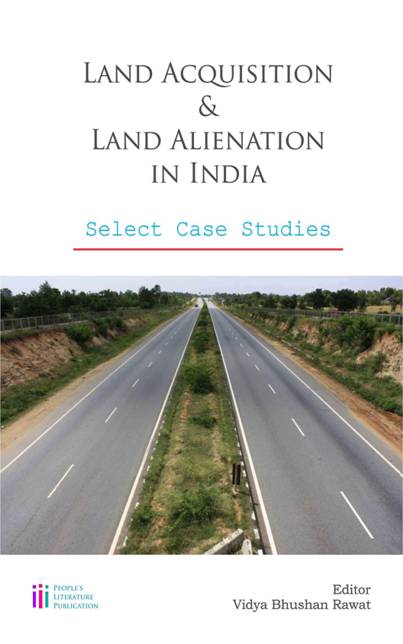New Book - Land Acquisition and Land Alienation in India by Vidya Bhushan Rawat
csss1
LAND ACQUISITION & LAND ALIENATION IN INDIA
SELECT CASE STUDIES
Editor: Vidya Bhushan Rawat
Published by: Peoples Literature Publication OPC Pvt Ltd. http://peoplespublication.com
 To
order mail: con...@peoplespublication.com
To
order mail: con...@peoplespublication.com
MRP: INR 550/-
Discounted Price: INR 330/- (40% discount)
Shipping: As per PIN code.
Pages: 131
ISBN 13 - 978-81-932525-0-5
Abstract:
In the past one decade, the fight for land rights grew multi-fold as governments continued with land grabbing and people struggled to protect their land. The government claimed its ‘authority’ of people and ‘consent’ by them while unrest grew everywhere as the democratic rights were curtailed and communities lost their livelihood without any concern shown by the authorities. Many of the writers and activists termed it as ‘attempt’ to turn the farmers and communities as landless in their own country.
Land has been an important part of human life. Land Reforms remain quintessential for social and gender justice. Land consolidation actually resulted in a highly inequitable society. India was among those very few nations that decided to abolish Zamindari and provide land rights to rural poor immediately after it became a republic in 1950. The government further went forward with its socialist agenda and brought in Land Ceiling Act to provide land to the last person of our society.
Even when officials were not honest in absolute terms to respect the ‘Directive Principles’ in the form of guidelines to Indian State, in terms of dutifully implementing it, the real changes appeared among Indian intellectuals in the aftermath of 1991 when Indian economy was ‘liberalised’ and government took extra steps to promote private capital and business investment in the country.
Suddenly, the greener regions of India, its vast and lush green forest zones became the target of big international and national corporations. The land was easily being occupied by the state in the name of ‘national interest’ under the colonial law of 1894 land acquisition act. Millions of acres of land were made easily available to greedy corporate houses, both national and international, without seeking any mandate from the people whether they want the project or not. Not only this, the irony was that there was no need for them to even think of any decent rehabilitation plan of those who lost their land and livelihood.
Case I
Maha Mumbai SEZ (MMSEZ) of Reliance Industries in Raigad, Navi Mumbai (Maharashtra)
Case II
Dadri Power Project, Reliance Power Ltd (India) of Anil Ambani, Dadri (Uttar Pradesh)
Case III
M/s Lanco Anpara Power Ltd., Bhognipur Tehsil, Ramabai Nagar District (Uttar Pradesh)
Case IV
Srinagar Hydro Electric Project, Garhwal (Uttarakhand)
Case V
Non-Distribution to the Landless SC/ST Agricultural Workers of the Surplus Lands Acquired from M/s Escort Farms (Ramgarh Ltd.), Kashipur, Shaheed Udham Singh Nagar District (Uttarakhand)
Case VI
Polavaram Dam, West Godavari (Andhra Pradesh)
Case VII
Vedanta Alumina Limited, Niyamgiri Hills, Rayagada (Odisha)
Case VIII
Bhavanapadu Thermal Power Project, Kakarapalli, Srikakulam (Andhra Pradesh)
Case IX
Nagdi People’s Movement against Land Acquisition, Ranchi (Jharkhand)
Case X
Struggle of Zadva Pastoralists for Commons, Lakhpat Block, Kutch (Gujarat)
Case XI
Women’s Access and Ownership of Land – A Case of Mizoram State in India (Mizoram)
Case XII
Arippa Land Struggle (Kollam district, Kerala State)
